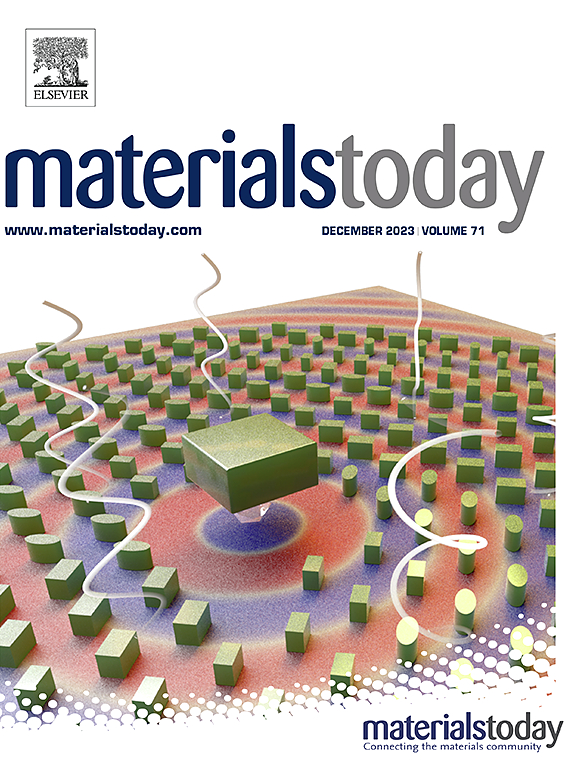How amorphous CoOx(OH)y-Pd nanocomposite endows high performance and durability in methanol oxidation reaction
IF 21.1
1区 材料科学
Q1 MATERIALS SCIENCE, MULTIDISCIPLINARY
引用次数: 0
Abstract
One key issue in designing electrocatalysts for methanol oxidation reaction (MOR) is to improve their durability because the dissociative adsorption of methanol molecule could produce CO-like intermediate to poison catalysts. Here, we propose a wet chemical route to anchor Pd nanoparticles on amorphous CoOx(OH)y nanoplates and show that such amorphous support prefers to bind OH from electrolyte during electrochemical reaction to increase surface OH coverage, helping remove the poisonous intermediates and recover active sites. Besides, the oxygen vacancies in the amorphous CoOx(OH)y enable to produce excess electrons that are transferred to Pd to facilitate rate-determining step of MOR. Furthermore, we have verified the synergistic effect between Pd species and the amorphous CoOx(OH)y nanoplate would generate more reactive oxygen species than the individual component catalyst to further enhance MOR activity. Consequently, the amorphous CoOx(OH)y-Pd nanocomposites deliver more excellent electrocatalytic performance of ∼7100 mA mgPd−1 and higher stability by retaining 86 % activity after 400 electrochemical cycles than Pd-loaded crystalline Co(OH)2 nanoplates. Notably, the leaching out of Pd component was overcome in our study, this catalyst can even work for more than 100 h without obvious activity loss. Such a strategy by integrating noble metal component with amorphous support shall open up a new avenue in smart design of MOR nanocatalysts with simplified synthesis routes and high activity yet low cost.
无定形CoOx(OH)y-Pd纳米复合材料如何在甲醇氧化反应中赋予高性能和耐久性
甲醇分子的解离吸附可产生co -样的毒性催化剂中间体,提高催化剂的耐久性是设计甲醇氧化反应电催化剂的关键问题。在这里,我们提出了一种湿化学途径将Pd纳米颗粒锚定在非晶CoOx(OH)y纳米板上,并表明这种非晶载体在电化学反应中倾向于结合电解质中的OH,以增加表面OH的覆盖率,有助于去除有毒中间体并恢复活性位点。此外,非晶CoOx(OH)y中的氧空位能够产生多余的电子,这些电子转移到Pd上,从而促进了MOR的速率决定步骤。此外,我们还验证了钯与非晶CoOx(OH)y纳米板之间的协同效应会比单个组分催化剂产生更多的活性氧,从而进一步提高MOR活性。因此,无定形CoOx(OH)y-Pd纳米复合材料具有更优异的电催化性能(约7100 mA mgPd - 1)和更高的稳定性,在400次电化学循环后,其活性保持86%,高于负载pd的Co(OH)2纳米板。值得注意的是,我们的研究克服了Pd组分的浸出,该催化剂甚至可以工作100 h以上而没有明显的活性损失。这种将贵金属组分与非晶载体相结合的策略,将为简化合成路线、高活性、低成本的MOR纳米催化剂的智能设计开辟一条新途径。
本文章由计算机程序翻译,如有差异,请以英文原文为准。
求助全文
约1分钟内获得全文
求助全文
来源期刊

Materials Today
工程技术-材料科学:综合
CiteScore
36.30
自引率
1.20%
发文量
237
审稿时长
23 days
期刊介绍:
Materials Today is the leading journal in the Materials Today family, focusing on the latest and most impactful work in the materials science community. With a reputation for excellence in news and reviews, the journal has now expanded its coverage to include original research and aims to be at the forefront of the field.
We welcome comprehensive articles, short communications, and review articles from established leaders in the rapidly evolving fields of materials science and related disciplines. We strive to provide authors with rigorous peer review, fast publication, and maximum exposure for their work. While we only accept the most significant manuscripts, our speedy evaluation process ensures that there are no unnecessary publication delays.
 求助内容:
求助内容: 应助结果提醒方式:
应助结果提醒方式:


